There’s an unexpected chill in the air as we head out from our hotel on the outskirts of Pamplona, Spain, dawn still 30 minutes away. Yet despite the early hour, it’s hard to contain the excitement about what’s to come.
It isn’t very often that we get to test a new sports car from the folks at Jaguar. Indeed, the last time the maker launched an all-new one was more than a half-century ago with the groundbreaking E-Type. While there have been tweener cars since then, such as the XK, none has truly targeted the sports car segment. Until now, with the Jaguar F-Type, that is.
Few new entries have generated more buzz in recent months, and with good reason. The 2-seater comes through with a blend of sensuous yet menacing styling that one would expect from Jaguar. And those good looks are complemented by exhilarating performance and dynamic handling. Is the new F-Type really the “best sports car in the world,” as Jaguar officials have started to boast? Here’s what we discovered during two days of hard driving both on-road and on-track.
You can tell that the legendary E-Type was top of mind when design chief Ian Callum and his team set to work. “I could feel the E-Type all the time while we were designing the F-Type,” he admitted during a walkaround of the new sports car. And who can blame him for looking back. A sports car is all about finding the most effective way of wrapping sheet metal around the mechanicals, as Callum likes to explain, and few products have ever done it more simply and elegantly.
Indeed, there is a joyous simplicity to the Jaguar F-Type. At a time when many vehicles seem, well, over-designed, with lots of swoops and curves and “character lines,” a caricaturist could capture the new sports car with just a handful of strokes. There’s one line that rises off the front bumper, through the headlamps and across the fenders, with another gracefully linking the two wheel arches.
Though not quite as long as the E-Type, the F-Type’s long hood features a distinct “power bulge” that adds to the overall sense of intimidation, especially if you’re viewing the new sports car coming up fast in your rearview mirror.
While one senses Jaguar heritage in the overall appearance of the E-Type, this is anything but a retro-mobile. Callum’s crew even tweaked the familiar oval grille. At the other end, there’s a lot more mass – and a real bumper, something you could skip in the ‘60s but not today.
On the other hand, the new F-Type avoids the tall rear deck – a Bangle-butt, if you will – that has become all but ubiquitous, these days, as makers struggle to improve aerodynamics. Instead, there’s a built-in spoiler that pops up when you approach highway speeds.
Jaguar also found an interesting solution to the door handle challenge. Rather than opt for some hidden button operating a fancy electronic mechanism, ala the Chevrolet Corvette, the new F-Type handles lie flush until you’re parked and ready to climb in, then they pop out where they’re quite easy to grab.
There are three different versions of the new Jaguar F-Type – with more to follow, we’re told – and the biggest distinction between V6 and V8 models can be seen from the rear. The F-Type V6 and V6 S have centrally mounted dual exhaust pipes. The quad pipes on the V8 S are pushed to the corners.
(Jaguar may be planning a 600-hp version of the new F-Type. Click Here for the story.)
Inside, Jaguar has opted for a clean and relatively simple layout that offers just the right balance between digital and analog technology. There is a proper pair of gauges — tach and speedo – flanking a central, reconfigurable LCD display. The large LCD screen in the center stack operates key infotainment systems and some vehicle functions though, to our great relief, there are real buttons, knobs and switches for tuning, volume, climate control – even for seat heaters.
Even the “base” F-Type V6 is elegantly outfitted in leather and aluminium, as the Brits prefer – with nary a splinter of wood, incidentally. There is no such thing as a “stripper” model with the new Jag.
Heading out on that cold morning we were surprised to see the top of the instrument panel begin to rise. The upper air vents remain hidden until they’re needed, an interesting detail.
Indeed, it’s all about details, and we appreciated the distinctive copper color of the steering wheel-mounted paddle shifters. On the center console, the rotary knob offered on other recent Jaguar models has been replaced by a pistol-grip e-shifter. Depending upon your point of view, the big disappointment is the lack of a stick shift – of which we’ll have more to come.
The seats, while appropriately low-slung were surprisingly easy to get into and out of. None of the convoluted gymnastics you must train for with your typical Lotus and so many other 2-seaters. The bolstering keeps you in your seat even during the hardest track maneuvers – and the outer wings, mercifully, could be adjusted to accommodate our middle-aged love handles.
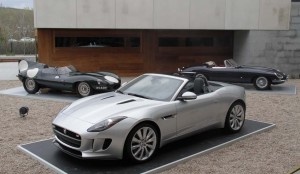
The new Jaguar F-Type with the legendary E-Type and the D-Type that dominated racing during the '50s.
There’s plenty of leg, head and shoulder room – but we’d have appreciated a bit more space in the cabin for stuffing away a small coat or bag. The trunk, meanwhile, is adequate but would be hard-pressed to handle even the smaller roll-on bag you might fit aboard a regional jet, so pack light.
Despite what turned out to be an unusually cold and wet couple days – the rain in Spain clearly not limited to the plains – we got to test the seat-heaters as much as the foldaway top. Both work great. You can go al fresco in a mere 12 seconds, and at speeds up to 30 mph, which is likely to encourage buyers to enjoy the wind in their face more frequently.
As we mentioned earlier, the Jaguar F-Type is offered in three different packages, each of which we had plenty of time to drive. The tendency is to refer to the $69,000 V-6 as the “base” package. Were it the only model available we’d be hard-pressed to use that term considering what it delivers for the money.
(Our test vehicle, we should note, added a few extra features, such as the mechanical Limited Slip Differential and the active exhaust system. The latter normally kicks in when the engine tops 4,500 RPMs, creating a wonderful burble that adds to the sense of raw power. You can tap the control on the center console and the system operates full-time.)
As with the rest of its line-up, Jaguar opted against turbocharging, and the choice of an Eaton twin-vortex supercharger paid off. There’s only the most modest sense of lag as the engine revs up to 3,500 RPMs, where it hits peak torque. At 340-hp and 332 lb-ft, it turns out some impressive numbers, especially with a 0 to 60 time of 5.1 seconds – just shy of what the Porsche Boxster S can deliver. Top speed is 161 mph.
All three versions of the Jaguar F-Type come equipped with the latest ZF 8-speed automatic. We can imagine some readers wincing at the idea. And our initial reaction was only slightly more reserved. But one thing we’ve come to realize in recent years, almost everything we thought we knew about gearboxes is wrong. Like the assumption that a stick is the only way to go. Check out the many converts who have opted for the double-clutch, or PDK, on the latest Boxster and 911 iterations. The damned things are just that good you’d be hard-pressed to out-shift them.
So, why not opt for a double-clutch? Because the way Jaguar has the ZF 8-speed set up you’d be hard-pressed to do any better. There’s a torque convertor operating only in first gear – which actually means a smoother launch, by the way – and eighth is only for overdrive. The transmission absolutely flies through the rest of the gears. Under normal driving conditions you’ll likely hear, rather than feel shifts. Pushing the limits, Jaguar engineers claim they’re seeing shift times exceeding most double-clutch alternatives. From a seat-of-the-pants perspective we can’t argue that.
Would we still like a manual? Of course. But should it matter? Probably not.
Just when we thought that base V-6 was all we needed, we pulled up to the new Circuito de Navarra, an F1-class track that Jaguar is using to test the mettle of the V-6 S.
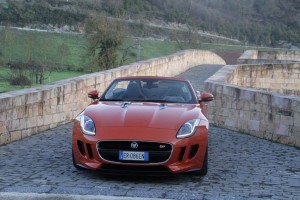
While Jaguar's heritage is obvious, Callum's team didn't want a retro-mobile, and even changed the familiar Jaguar oval grille.
After a few familiarization laps we felt confident enough to push the limits of this upgrade, increased boost and a few other tricks boosting the 3.0-liter six to 380 hp and 339 lb-ft – while cutting the 0 to 60 time to 4.8 seconds and raising top speed to 171 mph. At $81,000, the F-Type V6 S gets bigger tires, the limited slip and active exhaust packages and a few other niceties.
With a near-perfect 50:50 weight ratio, the F-Type has a confidence-inspiring poise on the street. You come to respect its overall balance even more on a highly technical track like the 2.4-mile Navarra. It’s an easy circuit to mess up. Miss one corner and you’re out of position for the next. Our track tutors encouraged us to take risks – noting the Formula One-grade run-offs. Despite several blown corners, we didn’t need them.
Yes, you can get the back end to come out a bit, especially if you shift to performance mode, reducing the intervention of the various brake-related systems like Stability Control. But the F-Type proved surprisingly forgiving, with the limited slip differential catching and correcting our worst mistakes without punishing us by scrubbing off a lot of speed.
After a few hours at the Circuito de Navarra, we completed the afternoon driving the V6 S through the hills and valleys surrounding Pamplona – quite a bit faster than we had during our morning run.
But the real thrill would follow the next morning as we took a circuitous, three-hour route to the airport and our trip home.
For those who want all the bells-and-whistles, there’s the $92,000 F-Type V8 S. As the name implies, you get the familiar 5.0-liter Jaguar V-8, here delivering 495-hp and 460 lb-ft of torque. Considering this model weighs in at just under 3,700 pounds, you’re up in exotic territory here and even pressing only halfway down on the throttle is going to sink you deep into those sport seats.
Jaguar is using what we consider a conservative 4.2 second figure for 0 to 60 times, with top speed limited to 186 mph. Whatever the numbers, the sense of raw power, matches by the rich blatt of the exhaust is an E-ticket thrill ride.
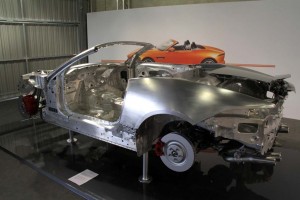
The Jaguar F-Type uses an aluminum body and platform - though it is still several 100 pounds heavier than a Porsche Boxster or 911.
The good news is that the V8 S beefs up the brakes, at 380 mm front and 376 mm rear, to scrub off that speed when needed. The V8 S also gets a more sophisticated electronically controlled Limited Slip Differential.
Adaptive dampers, meanwhile, are standard on both the S models and optional on the V6. They prove pleasantly adept at smoothing out all but the bumpiest roads while enhancing the F-Type’s overall sense of grip – though even the base car’s standard suspension proved to be quite willing to handle the most challenging corners with virtually no sense of understeer.
The F-Type’s consistent sense of poise is quite impressive considering both the front engine layout and the car’s overall mass. Despite the use of an aluminum body and platform, it weighs in between 3,521 and 3,671 pounds, depending on model.
In an interesting choice, Jaguar engineers decided to stick with a more conventional hydraulic steering assist system rather than the electro-mechanical versions generally taking over the industry – or the electro-hydraulic approach chosen by arch-rival Porsche. The result is immediately obvious: you feel absolutely in touch with both road and car through your fingertips.
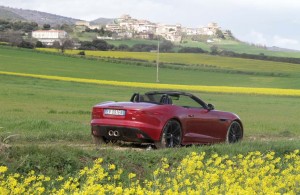
The F-Type is Jaguar's first true, new sports car since the launch of the original E-Type over 50 years ago.
That doesn’t mean you won’t get a few surprises. Go into a corner a little hot and the rear can jump out on you a bit, but there’s never a sense of panic. The slightest working of steering wheel and throttle will bring things rapidly back under control.
Incidentally, should it matter, Jaguar is expecting to see fuel economy running in the 28 mpg highway range for the V6, 27 for the V6 S and around 23 for the V8 S. Of course, that will vary widely depending on how hard you press the beast – and clearly, we expect few drivers to be satisfied simply sitting in traffic using the F-Type solely for the daily commute. If they do, incidentally, Jaguar has added mileage-boosting stop/start technology which can be readily switched off.
From the moment Jaguar unveiled the F-Type it has almost obsessively compared it to Porsche, both Boxster and 911. The reasons are obvious and there are comparisons both good and bad. True 911 aficionados, in particular, may not be readily won over to the heavier Jag, though we have a feeling the Brits will make some serious inroads in the broader sports car market.
The new Jaguar F-Type is just that good, just that visually striking, just that unique. Is it the “best sports car in the world”? We’ll reserve final judgment until we can arrange a direct shoot-out, both on –track and off. But that doesn’t mean we didn’t come away distinctly impressed. A half century is a long time but the F-Type was well worth the wait.

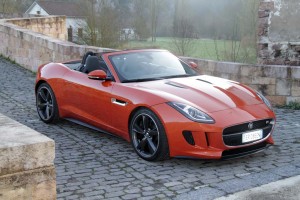
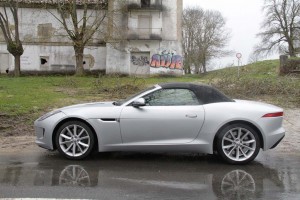
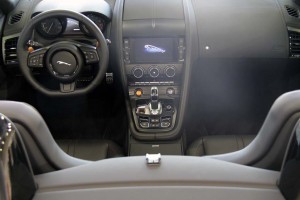
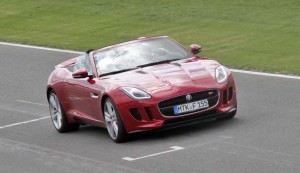
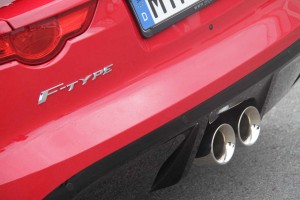
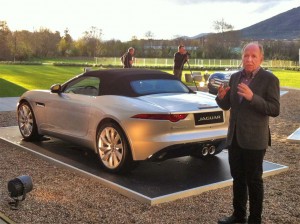
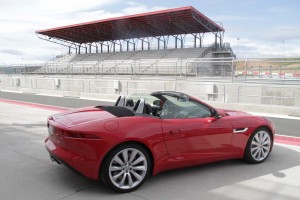
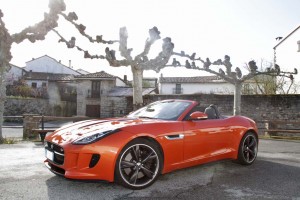
Sorry but this new Jag is a huge disappointment in styling – which is what most people use as the #1 priority in purchasing an auto. While styling is totally subjective, Fugliness is not and both the front and rear of the F-Type are horrible IMO. The side profile is excellent but they really blew it on the garish front end and stupid wrap-around tail lights. It’s obvious that many auto designers have lost sight of how to design a pleasingly style auto and instead have resorted to foolish light pods and front end gills and Happy Faces which are so numerous it’s a disgrace.
As far as performance you’d be hard pressed to consider a 3500 F-Type as a true sportscar regardless of how much power the engines deliver. The ZF 8-speed looks to be an excellent design bbut by design it’s impossible for a traditional full auto trans to shift quicker than a DTC as the clutch apply time for both are essentially eequal. That being said a torque converter will make launch from a stop more pleasing to most folks and improve performance via torque multiplication – which is likely why Jag chose to use a full auto. If this were a true sportscar and not a GT, then it would come with a manual and a DTC instead of the auto trans.
I think you’d better drive one before passing judgement. It looks great in person. The autotrans is lightning fast (the torque converter is locked after the 1-2 shift!) and not many DTC’s will beat it (drive a Ford with DTC and see how slow they can be). I own 6 cars, if you include the Citroën in our driveway in Italy, and only our minivan is an automatic. But I’ve now got to concede the new automatics can shift faster, choose the correct gear as well if set up for that, as I can.